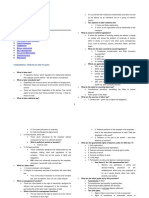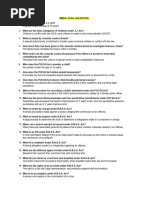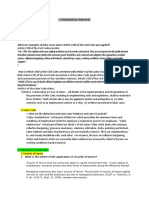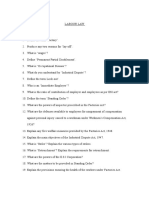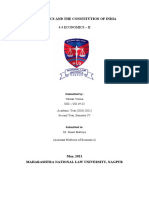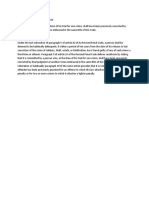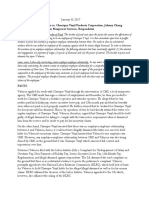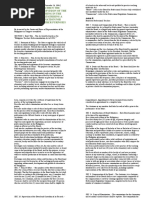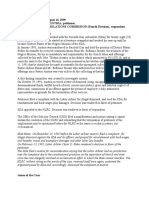LS Assignment 1 2B 2C
LS Assignment 1 2B 2C
Uploaded by
JuvylynPiojoCopyright:
Available Formats
LS Assignment 1 2B 2C
LS Assignment 1 2B 2C
Uploaded by
JuvylynPiojoOriginal Title
Copyright
Available Formats
Share this document
Did you find this document useful?
Is this content inappropriate?
Copyright:
Available Formats
LS Assignment 1 2B 2C
LS Assignment 1 2B 2C
Uploaded by
JuvylynPiojoCopyright:
Available Formats
LABOR STANDARDS LAW (November 24, 2020)
ASYNCHRONOUS LEARNING
INSTRUCTIONS:
HANDWRITE IN YELLOW LONG PAD
SUBMIT AT DEAN’S OFFICE USTLEGLAW ON OR BEFORE SATURDAY NOVEMBER 28,
2020
1. What matters may properly fall under the term “labor law”?
2. Classify labor statutes.
3. What is social legislation?
4. What is an (a) employer, (b) employee?
5. What is LABOR STANDARDS LAW?
6. Described briefly the relationship that arises between the employer and an employee.
7. In determining the existence of employer-employee relationship, what are the elements that are
generally considered?
8. Among the foregoing elements, what constitutes the most important index of the existence of the
employer-employee relationship?
9. What form of control will establish employer-employee relationship?
10. Is there any specific form of evidence required to prove the existence of employer-employee
relationship?
11. May the state regulate the relations between employer and employee? Explain.
12. Why must the State afford protection to labor?
13. Does protection to labor mean destruction of the employer?
14. How was the Labor Code of the Philippines enacted?
15. Why is it called “the Labor Code of the Philippines?
16. When did the Labor Code of the Philippines take effect?
17. Into how many books is the Labor Code divided?
18. What is the basic policy of the State as declared in the Labor Code?
19. Does the policy of the State in protecting the Labor means favoring the Labor Sector?
20. Are agricultural workers entitled to the rights and benefits under the Labor Code?
21. Are government employees covered by the Labor Code?
22. What is recruitment and placement?
23. Who can engage in or undertake recruitment and placement? (Art. 16)
24. Why is it that only those with authority or license can engage in recruitment and placement
activities?
25. Distinguish “authority” from ”license”
26. Define the following: contract worker, name hire, manning agency, placement fee, service fee,
overseas employment, valid employment contract, and principal.
27. May a foreign based employer or principal hire a Filipino worker overseas employment without
the intervention of the government or private entities authorized to engage in recruitment and
placement?
28. What government entity is charged with the implementation and enforcement of the laws in
recruitment and placement?
29. In case of illegal termination of the employment of the overseas Filipino workers, what relief
should be granted to him?
30. Who is responsible for the repatriation of the overseas Filipino workers?
31. What government agency should be responsible in case of repatriation?
32. Is there any citizenship qualification for a person or entity engaged in the recruitment and
placement of workers?
33. What are the prohibited practices in connection with recruitment and placement?
34. When is illegal recruitment considered a crime of economic sabotage and punishable with life
imprisonment?
35. Give the elements of illegal recruitment as a criminal offense?
You might also like
- Cojuangco, Jr. v. Republic of The PhilippinesDocument1 pageCojuangco, Jr. v. Republic of The PhilippinesKris Razo100% (3)
- Katarungang PambarangayDocument105 pagesKatarungang PambarangayJay-r Malazarte Bergamo100% (9)
- Electronic EvidenceDocument2 pagesElectronic EvidenceJoseph InocencioNo ratings yet
- LegRes Illegal RecruitmentDocument11 pagesLegRes Illegal RecruitmentPaul BalbinNo ratings yet
- Replication Reference FormatDocument14 pagesReplication Reference Formatdinesh50% (2)
- Sample Lease ContractDocument3 pagesSample Lease ContractBogz BorjaNo ratings yet
- Motion To Compel Answers To Deposition Questions of Ron Wolfe FDLGDocument63 pagesMotion To Compel Answers To Deposition Questions of Ron Wolfe FDLGForeclosure Fraud100% (3)
- Questions - Labour Law 08sep22Document4 pagesQuestions - Labour Law 08sep22An Huỳnh Hoàng NhậtNo ratings yet
- Employees Provident Fund Miscellaneous Provision Act 1952Document9 pagesEmployees Provident Fund Miscellaneous Provision Act 1952Arjoo BakliwalNo ratings yet
- Sample Questions For RTI ActDocument5 pagesSample Questions For RTI ActAnjali RaiNo ratings yet
- Tuazon Labor RevDocument78 pagesTuazon Labor RevianlaynoNo ratings yet
- Return of Refugees Prisoners of War Civil Detainees ToDocument3 pagesReturn of Refugees Prisoners of War Civil Detainees ToAnonymous rVdy7u5No ratings yet
- Consti Law QuestionDocument2 pagesConsti Law QuestionFatima CardenasNo ratings yet
- Chapter 1 Review QuestionsDocument3 pagesChapter 1 Review QuestionsjanellemanaoisNo ratings yet
- Labor LawsDocument68 pagesLabor LawsjrpatarasaNo ratings yet
- Labor Relations - Midterm Transcript 2014Document16 pagesLabor Relations - Midterm Transcript 2014Michael Francis HubahibNo ratings yet
- Mu LL2 QB YmkDocument6 pagesMu LL2 QB YmkRitika SinghNo ratings yet
- Vig Q&A QuizCompetitionDocument7 pagesVig Q&A QuizCompetitionpreetiNo ratings yet
- Assignment 003 2022Document2 pagesAssignment 003 2022KateDeseoNo ratings yet
- Consti 1 School Work 2 2024 2025Document2 pagesConsti 1 School Work 2 2024 2025Ralph AtosNo ratings yet
- Labor FinalsDocument357 pagesLabor FinalsAshAngeLNo ratings yet
- Lecture Notes Labor 9142023Document13 pagesLecture Notes Labor 9142023burgoslesliejNo ratings yet
- INTERNALSDocument5 pagesINTERNALSkalpeshNo ratings yet
- Labor Law Notes 2020Document99 pagesLabor Law Notes 2020Kim WaNo ratings yet
- pdfcrowd (11)Document4 pagespdfcrowd (11)rishusingh15.07.2003No ratings yet
- Labor Sector in The PhilippinesDocument13 pagesLabor Sector in The PhilippinesJae Kkim BefinosaNo ratings yet
- Conclusions andDocument30 pagesConclusions andTHIRUPATHIPERANo ratings yet
- PPTs UNIT IMBA HR02Document23 pagesPPTs UNIT IMBA HR02Amit KumarNo ratings yet
- Labor StandardsDocument10 pagesLabor Standardsmilcah valenciaNo ratings yet
- Guide Questions in Drafting the Employment ContractDocument4 pagesGuide Questions in Drafting the Employment Contractkp4yywztbcNo ratings yet
- Industrial Relation and Labour Laws 647602921 PDFDocument6 pagesIndustrial Relation and Labour Laws 647602921 PDFVicky Pd100% (1)
- Protection-To-Labor Clause: Part - Ii Law On Labor StandardsDocument4 pagesProtection-To-Labor Clause: Part - Ii Law On Labor StandardsMariaHannahKristenRamirezNo ratings yet
- Political Law QuestionsDocument4 pagesPolitical Law QuestionsImranAbubakarPangilinanNo ratings yet
- 2009 Labor Reviewer Part IIDocument55 pages2009 Labor Reviewer Part IIferdinand0911No ratings yet
- INDUSTRIAL LAWS UNIT 1Document51 pagesINDUSTRIAL LAWS UNIT 1aayushirai30No ratings yet
- Final Questions - Labour LawDocument3 pagesFinal Questions - Labour Lawhai280902No ratings yet
- Bill of Rights - Self-Assessment QuestionsDocument2 pagesBill of Rights - Self-Assessment QuestionspriscasamukeloNo ratings yet
- Labor-Review-Revalida-Guide-Questions.1Document5 pagesLabor-Review-Revalida-Guide-Questions.1Enric AlcaideNo ratings yet
- Frequently Asked Questions On Sexual Harassment of Women at Workplace (Prevention, Prohibition and Redressal) ACT & RULES, 2013Document20 pagesFrequently Asked Questions On Sexual Harassment of Women at Workplace (Prevention, Prohibition and Redressal) ACT & RULES, 2013Disability Rights AllianceNo ratings yet
- Labor Pre. 1Document35 pagesLabor Pre. 1Eduardo AnerdezNo ratings yet
- Labor AssignmentDocument6 pagesLabor AssignmentMae DianeNo ratings yet
- Withheld Assesment QuestionDocument35 pagesWithheld Assesment QuestionShashant NagwanshiNo ratings yet
- How Do Tough Economic Conditions Affect Employee RelationsDocument4 pagesHow Do Tough Economic Conditions Affect Employee RelationsRajarshi DasguptaNo ratings yet
- Labor Standards NewDocument204 pagesLabor Standards NewArkhe PlazaNo ratings yet
- Technical Questions GNLU CRADocument5 pagesTechnical Questions GNLU CRARuchir JoshiNo ratings yet
- labor-law (1)Document95 pageslabor-law (1)vthieunhanNo ratings yet
- Questions For LaborDocument3 pagesQuestions For Laborthe duchessNo ratings yet
- Constitutional Provisions Related To Industrial and Labor LawDocument11 pagesConstitutional Provisions Related To Industrial and Labor LawAditya Yash VyasNo ratings yet
- Public Rights and IN Accordance With The LawDocument35 pagesPublic Rights and IN Accordance With The LawBELLANo ratings yet
- A Study of Social Security Laws and Policy Relating To Labour in Organized Sector-2Document196 pagesA Study of Social Security Laws and Policy Relating To Labour in Organized Sector-2Suryakumar BendalamNo ratings yet
- Ankit Economics FINALDocument14 pagesAnkit Economics FINALDesh deepak shekhawatNo ratings yet
- Labor Law Review Online ExamDocument17 pagesLabor Law Review Online ExamKevin G. PerezNo ratings yet
- Domestic Workers' Laws and Legal Issues in India: Wiego Law & Informality ProjectDocument10 pagesDomestic Workers' Laws and Legal Issues in India: Wiego Law & Informality ProjectinderpreetNo ratings yet
- Quizes C A TaxDocument45 pagesQuizes C A TaxYeshua Liebt PhoenixNo ratings yet
- 2019-32 Chetan Verma1Document16 pages2019-32 Chetan Verma1chetan vermaNo ratings yet
- Gananotes1-Dwnloaded From Law School FunkDocument69 pagesGananotes1-Dwnloaded From Law School FunkbobbysingersyahooNo ratings yet
- CUESTIONARIO PARA SEGUNDO PARCIALllllDocument7 pagesCUESTIONARIO PARA SEGUNDO PARCIALlllldayanadiazmorales10No ratings yet
- Labor Law Fundamental Principles and PoliciesDocument4 pagesLabor Law Fundamental Principles and PoliciesJowi SuNo ratings yet
- Job Creation in The Employment Sector 4Document11 pagesJob Creation in The Employment Sector 4محمد اسمي بن مولياديNo ratings yet
- Labour Law Project 4Document25 pagesLabour Law Project 4Vaibhav GuptaNo ratings yet
- The Bruce R. Hopkins Nonprofit Law Library: Essential Questions and AnswersFrom EverandThe Bruce R. Hopkins Nonprofit Law Library: Essential Questions and AnswersNo ratings yet
- CUI Fundamentals: 100 Questions (and Answers) About the United States Government's Controlled Unclassified Information ProgramFrom EverandCUI Fundamentals: 100 Questions (and Answers) About the United States Government's Controlled Unclassified Information ProgramNo ratings yet
- Drafting Tribal Employment Laws & Handbooks: A Practical Guide to Drafting Tribal Employment Laws and the Policies Included in Government and Enterprise Employee Handbooks for Tribal Leaders, Administrators, Lawyers, Directors, and ManagersFrom EverandDrafting Tribal Employment Laws & Handbooks: A Practical Guide to Drafting Tribal Employment Laws and the Policies Included in Government and Enterprise Employee Handbooks for Tribal Leaders, Administrators, Lawyers, Directors, and ManagersNo ratings yet
- Land Titles and Deeds Case Digest 1Document3 pagesLand Titles and Deeds Case Digest 1JuvylynPiojoNo ratings yet
- DepEd v. TuliaoDocument2 pagesDepEd v. TuliaoJuvylynPiojoNo ratings yet
- LC DigestDocument34 pagesLC DigestJuvylynPiojoNo ratings yet
- Habitual DelinquencyDocument1 pageHabitual DelinquencyJuvylynPiojoNo ratings yet
- Transpo - I III DigestDocument23 pagesTranspo - I III DigestJuvylynPiojoNo ratings yet
- G.R. No. L-35927 March 3l, 1978 Benedicto Padasas, Petitioner, vs. The Honorable Court of Appeals and Avelina M. BENTAJADO, RespondentsDocument21 pagesG.R. No. L-35927 March 3l, 1978 Benedicto Padasas, Petitioner, vs. The Honorable Court of Appeals and Avelina M. BENTAJADO, RespondentsJuvylynPiojoNo ratings yet
- Transpo - I III DigestDocument38 pagesTranspo - I III DigestJuvylynPiojo100% (1)
- I. Common Carrier A. Concept (Article 1732, NCC) Spouses Dante Cruz and Leonora Cruz, Petitioners, vs. Sun Holidays, Inc., Respondent. DecisionDocument39 pagesI. Common Carrier A. Concept (Article 1732, NCC) Spouses Dante Cruz and Leonora Cruz, Petitioners, vs. Sun Holidays, Inc., Respondent. DecisionJuvylynPiojoNo ratings yet
- Case List 1 10Document63 pagesCase List 1 10JuvylynPiojoNo ratings yet
- Agrarian Reform HistoryDocument6 pagesAgrarian Reform HistoryJuvylynPiojoNo ratings yet
- Emilia E. Andres vs. Stanley R. Cabrera G.R. No. 585 December 14, 1979 FactsDocument2 pagesEmilia E. Andres vs. Stanley R. Cabrera G.R. No. 585 December 14, 1979 FactsJuvylynPiojoNo ratings yet
- Transpo - III. CONTRACT OF CARRIAGE OF PASSENGERSDocument21 pagesTranspo - III. CONTRACT OF CARRIAGE OF PASSENGERSJuvylynPiojoNo ratings yet
- Case 21 28Document39 pagesCase 21 28JuvylynPiojoNo ratings yet
- Canons 1-6, CPRDocument3 pagesCanons 1-6, CPRJuvylynPiojoNo ratings yet
- I. Common Carrier A. Concept (Article 1732, NCC) : Beach III, Which Was To Ferry Them To BatangasDocument43 pagesI. Common Carrier A. Concept (Article 1732, NCC) : Beach III, Which Was To Ferry Them To BatangasJuvylynPiojoNo ratings yet
- Canons 1-6, CPRDocument3 pagesCanons 1-6, CPRJuvylynPiojo100% (1)
- ARCIGA vs. MANIWANGDocument5 pagesARCIGA vs. MANIWANGJuvylynPiojoNo ratings yet
- Arbitration Law - ADR Law Cases 9-13Document67 pagesArbitration Law - ADR Law Cases 9-13JuvylynPiojoNo ratings yet
- Matrix Rules On Civil Procedure 1Document30 pagesMatrix Rules On Civil Procedure 1JuvylynPiojoNo ratings yet
- Second Report On General Principles of Law Vazquez BermudezDocument59 pagesSecond Report On General Principles of Law Vazquez BermudezJuvylynPiojoNo ratings yet
- Mejoff Vs Director of Prisons: FactsDocument10 pagesMejoff Vs Director of Prisons: FactsWindy Awe MalapitNo ratings yet
- Rule 23, 25 of RocDocument4 pagesRule 23, 25 of RocKeith Adamson PunzalanNo ratings yet
- Whigham Vs Sparc Group RetailDocument4 pagesWhigham Vs Sparc Group RetailHorace TolliverNo ratings yet
- Business Law - All SlidesDocument478 pagesBusiness Law - All Slidesshreyansh120No ratings yet
- MAGLANGITDocument3 pagesMAGLANGITNOLIE LENTIJANo ratings yet
- Cea 2023 2024Document3 pagesCea 2023 2024ajuklm88No ratings yet
- Director of Public Prosecutions Vs Daudi Pete (1991) TZCA 9 (16 May 1991) - TanzliiDocument9 pagesDirector of Public Prosecutions Vs Daudi Pete (1991) TZCA 9 (16 May 1991) - TanzliiStewart AlfredNo ratings yet
- YusufDocument8 pagesYusufAdila Nabila N.JNo ratings yet
- Valencia Vs Classique Vinyl ProductsDocument2 pagesValencia Vs Classique Vinyl ProductsDelsie Falculan100% (2)
- Main Speech Morning Court MasterDocument7 pagesMain Speech Morning Court MasterDipansha GargNo ratings yet
- Benjamin Ayemoba Ayebae, A073 602 922 (BIA May 1, 2014)Document9 pagesBenjamin Ayemoba Ayebae, A073 602 922 (BIA May 1, 2014)Immigrant & Refugee Appellate Center, LLCNo ratings yet
- Adp Sa en in ThinkDocument4 pagesAdp Sa en in ThinkKshitij TrivediNo ratings yet
- Shauf Vs Court of AppealsDocument3 pagesShauf Vs Court of AppealsRA BautistaNo ratings yet
- 10 Chavez Vs CA 24 Scra 663Document19 pages10 Chavez Vs CA 24 Scra 663LalaLanibaNo ratings yet
- LTD Finals Digests 1Document41 pagesLTD Finals Digests 1Erxha LadoNo ratings yet
- One Day Revision Final File - Watermark - 25586058 - 2023 - 11!21!23 - 24Document31 pagesOne Day Revision Final File - Watermark - 25586058 - 2023 - 11!21!23 - 24Priyanshu tripathiNo ratings yet
- Legal Aid SchemesDocument13 pagesLegal Aid SchemesPranav SharmaNo ratings yet
- Ra 7836Document7 pagesRa 7836mizraimNo ratings yet
- PHILIPPINE BANKING CORPORATION Vs LUI SHEDocument2 pagesPHILIPPINE BANKING CORPORATION Vs LUI SHEoabeljeanmonique100% (4)
- Austria vs. NLRC DigestDocument4 pagesAustria vs. NLRC DigestKhen TamdangNo ratings yet
- "Personality Rights" and Why Mars Argo Has A CaseDocument5 pages"Personality Rights" and Why Mars Argo Has A CaseDangeresque MustachioNo ratings yet
- TugasDocument4 pagesTugasendang wahyuniNo ratings yet
- (CD) Dipad v. Olivan - G.R. No. 168771 - July 25, 2012 - AZapantaDocument2 pages(CD) Dipad v. Olivan - G.R. No. 168771 - July 25, 2012 - AZapantaAmiel Gian Mario ZapantaNo ratings yet
- 03 - de Guzman Vs de DiosDocument1 page03 - de Guzman Vs de DiosMary Grace Baynosa-CoNo ratings yet










